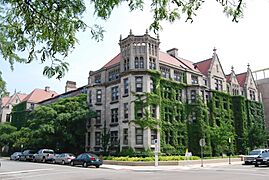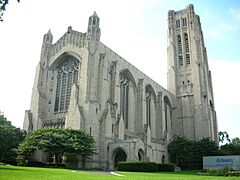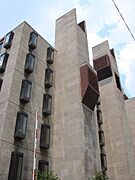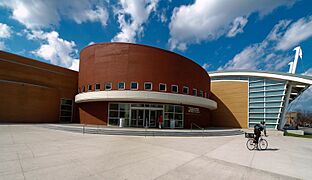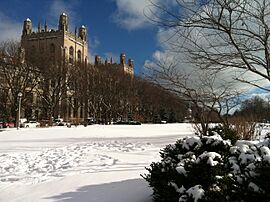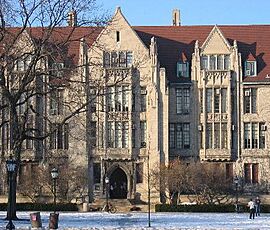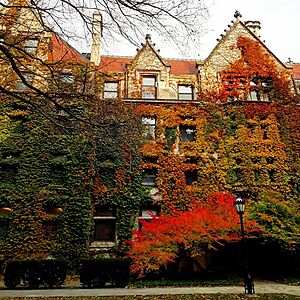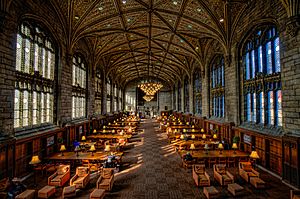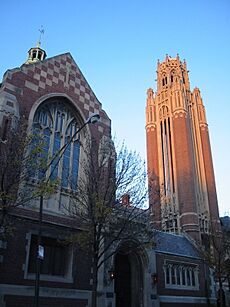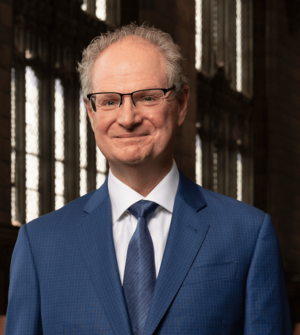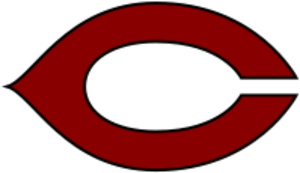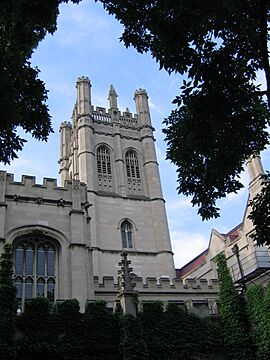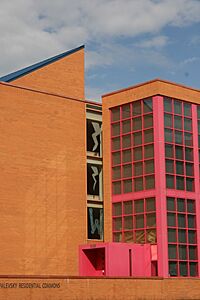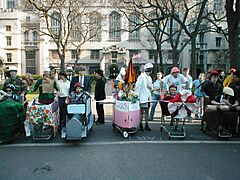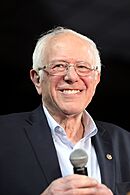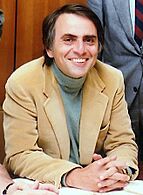University of Chicago facts for kids
 |
|
| Motto | Crescat scientia; vita excolatur (Latin) |
|---|---|
|
Motto in English
|
"Let knowledge grow from more to more; and so be human life enriched" |
| Type | Private research university |
| Established | 1890 |
| Founder | John D. Rockefeller |
| Accreditation | HLC |
|
Academic affiliations
|
|
| Endowment | $10.1 billion (2024) |
| President | Paul Alivisatos |
|
Academic staff
|
3,418 (2023) |
|
Administrative staff
|
23,217 (2023) |
| Students | 19,287 (2024) |
| Undergraduates | 7,569 (2024) |
| Postgraduates | 10,968 (2024) |
|
Other students
|
750 (non-degree seeking, 2024) |
| Location |
,
,
United States
41°47′23″N 87°35′59″W / 41.78972°N 87.59972°W |
| Campus | Large city, 217 acres (87.8 ha) (main campus) |
| Other campuses |
|
| Newspaper | The Chicago Maroon |
| Colors | Maroon |
| Nickname | Maroons |
|
Sporting affiliations
|
NCAA Division III –
|
| Mascot | Phil the Phoenix |
 |
|
The University of Chicago (often called UChicago or just Chicago) is a private research university located in Chicago, Illinois, United States. Its main campus is in the Hyde Park neighborhood.
This university is made up of an undergraduate college and four graduate divisions. These divisions cover subjects like Biological Science, Arts & Humanities, Physical Science, and Social Science. The university also has eight professional schools for subjects like business, social work, and law. UChicago also has locations in other cities around the world, including London, Hong Kong, and Paris.
Scholars from the University of Chicago have helped shape many important subjects, such as economics, law, and physics. They even started famous ways of thinking, known as the "Chicago schools" in various fields. A major scientific breakthrough happened here: the world's first human-made, self-sustaining nuclear reaction. This took place in 1942 under the university's Stagg Field. The university also helps manage important science labs like Fermi National Accelerator Laboratory and Argonne National Laboratory.
Many amazing people have been part of the University of Chicago. As of 2025, 101 Nobel Prize winners have been connected to the university as students, teachers, or staff. Its faculty and alumni also include winners of other major awards, like the Fields Medal for mathematics and the Pulitzer Prize for journalism.
Contents
Discovering UChicago's Past
How the University Began
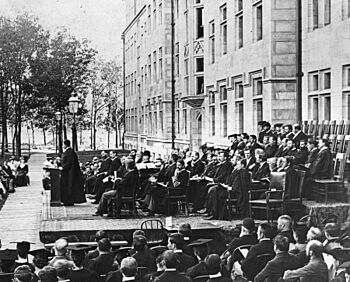
The first University of Chicago was started in 1856 by a group of Baptist educators. It faced money problems and closed in 1886. Later, its leaders decided to call it the "Old University of Chicago" so a new school could use the city's name.
In 1890, a new University of Chicago was created. It was for both boys and girls. This new university received money from Standard Oil co-founder John D. Rockefeller and land from Marshall Field. The university's symbol, a phoenix rising from ashes, reminds everyone of the old university's struggles and new beginning.
William Rainey Harper became the university's first president in 1891. Classes officially started on October 1, 1892. Harper quickly built a strong team of teachers. He also brought the Baptist seminary, a school for religious studies, to the university. This became the Divinity School in 1891.
In 1892, Amos Alonzo Stagg joined the university to coach football. He was a physical education professor and invented things like the numbered football jersey and the huddle. The university's Stagg Field is named after him. In 1894, the university chose maroon as its official color, and its sports teams became known as the Maroons.
The business school opened in 1898, and the law school opened in 1902. In 1911, the university chose its Latin motto: Crescat scientia; vita excolatur. This means "Let knowledge grow from more and more; and so be human life enriched."
Important Years: 1920s to 1980s
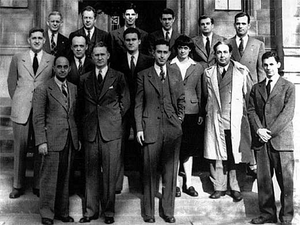
In 1929, Robert Maynard Hutchins became the university's president. He made many changes, including creating a special core curriculum for undergraduate students. He also stopped varsity football to focus more on academics. During his time, the University of Chicago Hospitals opened.
During World War II, the university's Metallurgical Laboratory was part of the Manhattan Project. This is where Enrico Fermi created the first controlled, self-sustained nuclear reaction in 1942.
In the 1960s, students at the university joined protests. For example, in 1962, Bernie Sanders helped lead a protest about the university's off-campus housing rules. In 1967, the university released the Kalven Report, which said that a university should be a place for free thinking and stay independent from political trends.
In 1978, Hanna Holborn Gray became president. She was the first woman to lead a major university in the United States.
Recent Times: 1990s to 2020s
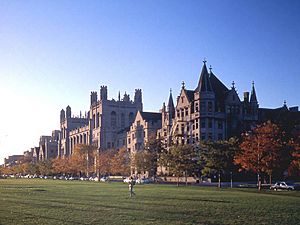
In 1999, the university changed its core curriculum, making it a bit more flexible. This led to a national discussion about education.
Since the mid-2000s, the university has been building many new facilities. In 2008, David G. Booth donated $300 million to the Booth School of Business. This was the largest gift ever given to a business school. In 2019, the university created its newest school, the Pritzker School of Molecular Engineering.
In April 2024, students held a peaceful protest on campus as part of a nationwide movement. The university police department cleared the protest area on May 7, 2024.
Exploring the Campus
Main Campus Features
The main campus of the University of Chicago covers 217 acres (87.8 ha) in the Hyde Park and Woodlawn neighborhoods of Chicago. It's about eight miles (13 km) south of downtown Chicago. A large park called the Midway Plaisance divides the northern and southern parts of the campus. In 2011, Travel+Leisure magazine called it one of the most beautiful college campuses in the United States.
The first buildings on campus, known as the Main Quadrangles, were designed in a style called Collegiate Gothic. This style looks like the old colleges at the University of Oxford in England. For example, Mitchell Tower looks like Oxford's Magdalen Tower.
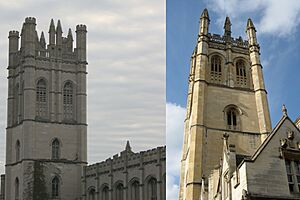
After the 1940s, newer buildings started to use modern designs. Famous architects like Eero Saarinen and Ludwig Mies van der Rohe designed buildings on campus. The Regenstein Library, the largest building on campus, is an example of brutalist style. In 2011, the Joe and Rika Mansueto Library opened, with a unique glass dome and an automated system to store books.
Several important historical sites are on campus. The spot where Chicago Pile-1 (the first nuclear reaction) happened is a National Historic Landmark. It's marked by a sculpture called Nuclear Energy. The Robie House, a famous building by Frank Lloyd Wright, is also on campus and is a UNESCO World Heritage Site.
Near the campus, in Jackson Park, is the future home of the Barack Obama Presidential Center. This will be the presidential library for the 44th president of the United States. Barack Obama and Michelle Obama lived in the Hyde Park neighborhood, and Michelle Obama worked at the university.
- Campus of the University of Chicago
-
Rockefeller Chapel, built in 1928, has a neo-Gothic design.
Getting Around Campus
The university campus is connected to downtown Chicago by public transportation like the CTA Red Line and Green Line trains. The university also has its own shuttle bus system that helps students get around Hyde Park and to other university locations. In 2024, a new ride-sharing program called Via was introduced, offering free rides on campus in shared vans.
Keeping Students Safe
The University of Chicago works hard to keep its campus safe. It has one of the largest private police forces in the country. The university has increased patrols, works closely with the Chicago Police, and uses security cameras to help ensure safety.
Other University Locations
Besides its main campus, the University of Chicago has facilities in other parts of the world. The Booth School of Business has campuses in Hong Kong, London, and downtown Chicago. The Center in Paris, located on the left bank of the Seine River, hosts many study programs. The university also has centers in Beijing, New Delhi, and Luxor, Egypt, for research and studies. In 2024, the John W. Boyer Center in Paris opened, making the Paris campus much larger.
What Students Learn
The University of Chicago offers many academic programs. It has an undergraduate college, four graduate research divisions, seven professional schools, and a school for continuing education. The university also has a large library system, its own publishing company (University of Chicago Press), and a medical center. It also helps manage important research labs like Fermi National Accelerator Laboratory and Argonne National Laboratory.
The university uses a quarter system, which means the school year is divided into four terms: Summer, Autumn, Winter, and Spring. Most students take three to four classes each quarter. The school year usually starts in late September and ends in late May.
The Undergraduate College
The College of the University of Chicago offers Bachelor of Arts and Bachelor of Science degrees. Students can choose from 51 main subjects (called majors) and 33 smaller subjects (called minors). The college's studies are divided into four areas: Biological Sciences, Physical Sciences, Social Sciences, and Humanities.
The college is known for its "core curriculum," which means all students take a set of required classes in different subjects. This helps students get a broad education.
Graduate Schools and Research
The university has many graduate programs for students who want to continue their studies after college. In 2022, over 10,000 graduate students were studying at UChicago.
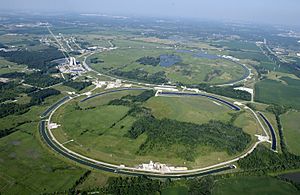
The University of Chicago is a major research university. It spends hundreds of millions of dollars on research each year. It is a founding member of the Association of American Universities, a group of leading research universities.
The university has over 140 research centers. These include the Institute for the Study of Ancient Cultures, West Asia & North Africa, which is a museum and research center for studies about the ancient Near East. UChicago also helps manage Argonne National Laboratory and Fermilab, which are important science labs.
Many famous scientific discoveries and ideas came from the University of Chicago. It's the birthplace of the Chicago school of economics, a way of thinking about how economies work. The university's sociology department was the first of its kind in the United States. The first controlled nuclear chain reaction happened here, and Willard F. Libby developed radiocarbon dating here in 1946. The famous Miller–Urey experiment, which tested how life might have started on Earth, was also done at UChicago.
Professional Schools
The university has eight professional schools that train students for specific careers:
- The University of Chicago Divinity School (for religious studies) was the first professional school, started in 1865.
- The Graham School of Continuing Liberal and Professional Studies (for ongoing education) was established in 1892.
- The Booth School of Business (for business) was founded in 1898. It is often ranked among the top business schools in the U.S.
- The University of Chicago Law School (for law) was established in 1902. It is also highly ranked.
- The Crown Family School of Social Work, Policy, and Practice (for social work) started in 1908.
- The Pritzker School of Medicine (for medicine) welcomed its first students in 1927.
- The Irving B. Harris School of Public Policy (for public policy) was established in 1988.
- The Pritzker School of Molecular Engineering (for molecular engineering) was founded in 2019.
Other Academic Programs
The university also runs the University of Chicago Laboratory Schools, a private school for students from kindergarten through 12th grade. It also manages public charter schools on the South Side of Chicago.
Library System
The University of Chicago Library system has six libraries with over 11 million books and other materials. The main library is the Regenstein Library, which has over 4.5 million books. The Joe and Rika Mansueto Library has a unique design and an automated system to store and retrieve books.
Arts at UChicago
The University of Chicago has a strong arts program. It includes academic departments, student art groups, and professional organizations like the Court Theatre and the Smart Museum of Art. The university offers degrees in music, film studies, visual arts, and more. Students can also take classes in art history, creative writing, and theater.
The university was home to the improvisational comedy group Compass Players, which later became the famous The Second City comedy theater. The Reva and David Logan Center for the Arts, which opened in 2012, provides spaces for art shows, performances, and classes.
University Leadership and Money
The university is led by a board of trustees and a president. The current president is Paul Alivisatos, who started in September 2021. The university has a large endowment, which is money saved up to support the school's activities. In 2024, it was about $10.1 billion.
The university's total budget in 2024 was $5.2 billion, which includes the university itself, its medical center, and the marine biological laboratory.
Students and How to Get In
In 2024, the university had over 7,500 undergraduate students and nearly 11,000 graduate students. About 53% of undergraduate students were male and 47% were female. Students came from many different backgrounds, with 27% identifying as Asian, 19% as Hispanic, and 10% as Black. About 18% of the students were from other countries.
Getting into the University of Chicago has become very competitive. In 2023, only about 4.7% of applicants were accepted. In 2018, the University of Chicago made headlines by becoming the first major research university to no longer require SAT or ACT scores from college applicants.
Sports at UChicago
The University of Chicago has 19 varsity sports teams, known as the Maroons. They compete in NCAA Division III as part of the University Athletic Association (UAA). Their mascot is Phil the Phoenix.
The university was once a founding member of the Big Ten Conference and played in NCAA Division I for sports like basketball and football. In 1935, Chicago Maroons football player Jay Berwanger won the first Heisman Trophy. However, the university left the Big Ten in 1946 to focus more on academics. Football was brought back in 1969 as a Division III team.
The university also has a Rugby Football Club (UCRFC) and an ultimate frisbee team called UChicago Fission.
Student Life and Fun Traditions
| Race and ethnicity | Total | ||
|---|---|---|---|
| White | 31% |
|
|
| Asian | 20% |
|
|
| Foreign national | 16% |
|
|
| Hispanic | 17% |
|
|
| Other | 9% |
|
|
| Black | 7% |
|
|
| Economic diversity | |||
| Low-income | 14% |
|
|
Student Groups
Students at the University of Chicago can join over 400 clubs and organizations. These include groups for different cultures, religions, academic interests, and hobbies. Some famous student groups include Doc Films, a student film society that has been running for a long time, and The Chicago Maroon, the weekly student newspaper.
Student Housing
Undergraduate students at UChicago live in a "house system." This means each student is part of a smaller community within their dorm building. There are 39 houses, each with about 70 students. Starting with the Class of 2023, students are required to live on campus for their first two years. About 60% of undergraduate students live on campus.
Fun Traditions
Every May since 1987, the university holds the University of Chicago Scavenger Hunt, where teams of students search for unusual items from a long list. In January, there's a winter festival called Kuviasungnerk/Kangeiko (Kuvia), which includes early morning exercises. The university also has a carnival and concert called Summer Breeze, and Doc Films shows movies every night. Since 1946, the university has hosted the Latke-Hamantash Debate, a funny discussion about two traditional foods.
Famous People from UChicago
Since 1890, 101 Nobel Prize winners have been connected to the University of Chicago. Many of them were doing research or teaching at the university when they won their awards. These Nobel Prizes were for Physics, Chemistry, Physiology/Medicine, Literature, Peace, and Economics.
Many UChicago alumni have become famous in different fields. They include CEOs of major companies like Microsoft and Goldman Sachs, leaders of countries, U.S. Cabinet Secretaries, and U.S. Senators.
Famous teachers at UChicago have included former U.S. president Barack Obama, poet T.S. Eliot, and writer Ralph Ellison.
UChicago in Pop Culture
The University of Chicago is the school attended by fictional characters like Harry Burns and Sally Albright from When Harry Met Sally..., Indiana Jones, and Mark Watney from The Martian. The campus has also been used as a filming location for movies like Divergent and The Fugitive.
See also
 In Spanish: Universidad de Chicago para niños
In Spanish: Universidad de Chicago para niños




